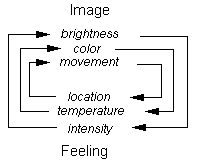Synaesthesia: synesthesia links have to do with the mutual influence between sensory representations. Certain qualities of feelings may be linked to certain qualities of imagery - for example, the intensity of a feeling may be linked to the brightness of an image; the color of an image (red or blue, for instance) may influence the temperature of a feeling; people may feel the impact of a particular image at different locations in their bodies depending on its quality of movement; and so on. Synesthesia is at the basis of our appreciation of art. They are also the basis of the so-called "fuzzy functions".
 |
Fuzzy Functions: "Fuzzy Functions" were defined by John Grinder and Richard Bandler in The Structure of Magic Volume II (1976) as a connecting or overlapping of our sensory representational systems. Technically, Grinder and Bandler define "fuzzy functions" as:
* Any modeling involving a representational system and either an input channel or an output channel in which the input or output channel involved is a different modality from the representational system with which it is being used. In traditional psychophysics, this term, 'fuzzy function', is most closely translated by the term 'synesthesia'.
Hearing a loud noise (auditory input channel) and feeling startled or frightened (kinesthetic representational system), for example, is a "fuzzy function" because the sound has overlapped onto physical and emotional sensations. Seeing internal imagery while listening to music, or having emotional responses to seeing various facial expressions would also be a results of "fuzzy functions." Fuzzy functions are typically characterized by terms such as "see-feel" or "hear-feel" circuits. According to Grinder and Bandler, fuzzy functions are the way in which our experience acquires meaning, but can also be the source of confusion and stress. Fuzzy functions create problems when they lead to stuck states and when we have no choice about them. Problematic fuzzy functions can be dealt with by sorting and separating the representational channels that have become fused or confused. This can be accomplished a variety of ways. Accessing Cues and Submodality interventions can be used to help people clarify and influence different aspects of their sensory experience.
—Source: Robert Dilts, Santa Cruz, CA. Edited by Dr. Hugo Heyrman, Antwerp, BE.
![]()
|| Museums of the Mind ||